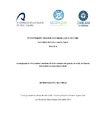Please use this identifier to cite or link to this item:
https://accedacris.ulpgc.es/jspui/handle/10553/74801
| DC Field | Value | Language |
|---|---|---|
| dc.contributor.advisor | Zamorano Serrano, María Jesús | - |
| dc.contributor.advisor | Courtois De Vicose, Gercende | - |
| dc.contributor.author | Abbas, Ahmed Salama Ali | - |
| dc.date.accessioned | 2020-10-16T12:27:31Z | - |
| dc.date.available | 2020-10-16T12:27:31Z | - |
| dc.date.issued | 2016 | en_US |
| dc.identifier.uri | https://accedacris.ulpgc.es/handle/10553/74801 | - |
| dc.description.abstract | Haliotis tuberculata coccinea is a promising candidate species for sustainable and integrated aquaculture development of the Canary Islands, a lot of studies focused on the technical improvement of culture systems of this species have been conducted in the PCTM of ULPGC. However, genetic studies investigating the genetic resources of its broodstock population to allow improved manipulation of the seed production procedures, to keep an acceptable genetic variability level and to prevent a possible genetic drift for such a broadcast spawning species, were still to be developed. Therefore, the present study was designed to have insights into the genetic structure of the existing broodstock. A group of microsatellite markers, belonging to other abalone species, were selected and grouped in to two multiplex PCRs which were used to develop one single multiplex PCR (MULTHAB) optimized for amplification of only 8 microsatellite primers after the exclusion of monomorphic and non-amplified primer pairs. The aim of this study is to assess the usefulness of using this multiplex to study the genetic diversity of H. tuberculata coccinea broodstock. 316 DNA samples were used and included: 16 samples from F1 animals that are part of the breeder group composed of different hatchery generations and 300 DNA samples that belonged to the next F2 generation obtained from the F1 breeder group. A total number of 80 alleles were detected for the 8 selected microsatellite markers in MULTHAB multiplex in all analyzed samples. They showed good allelic polymorphism with moderate allelic number per locus (NA) and expected heterozygosity(He) values, (mean= 10 and 0.6299, respectively). High PIC number values (mean =0.5753) for all used loci in this study were observed, suggesting that the selected markers showed a high capability to detect polymorphisms in a given population of H. tuberculata coccinea. The 8 microsatellite markers were successfully segregated in two identified families produced within this study. The optimized MULTHAB succeed to assign 32% of the F2 analyzed individuals to their possible parent pair or single parent. The mean FST value (0.0103) obtained in this study shows a little genetic differentiation between the parent group (F1) and the offspring group (F2). The high unbalanced samples size of F1 population (16 individual) and F2 population (300 individuals) resulted in unexpected observation for the allelic number per locus and the expected heterozygosity which were higher in F2 animals than those of F1 animals.There was high deviation from the linkage equilibrium and the H-W equilibrium for the studied microsatellite loci in all the broodstock population. Additionally, the mean FIS was positive (0.0899), this results indicates that the studied population was affected by a somehow loss of genetic diversity due to heterozygosity deficiency, inbreeding and founder problems, which was expected due to the crossing between parents and offspring of different generations for seed production. This study concludes the successful applicability of the developed MULTHAB multiplex for genetic studies for H. tuberculata coccinea brood stock, there is little genetic differences between the parent animals (F1) and their offspring (F2) with marks of heterozygote deficiency probably due to inbreeding and small number of founder animals, leading to reduction of genetic variability on the long run. This results indicate that adequate genetic maintenance should be implemented for the H. tuberculata coccinea broodstock population. | en_US |
| dc.language | eng | en_US |
| dc.relation | DIETABS (AGL2013-48831-R), Ministerio de Economía y Competitividad | en_US |
| dc.subject | 251092 Acuicultura marina | en_US |
| dc.subject.other | Haliotis tuberculata coccinea | es |
| dc.subject.other | Genetic diversity | es |
| dc.subject.other | PCR múltiplex | es |
| dc.title | Development of DNA marker multiplex PCR to estimate the genetic diversity of "Haliotis tuberculata coccinea" brood-stock | en_US |
| dc.type | info:eu-repo/semantics/masterThesis | en_US |
| dc.type | MasterThesis | en_US |
| dc.contributor.departamento | Departamento de Patología Animal, Producción Animal, Bromatología y Tecnología de Los Alimentos | en_US |
| dc.contributor.facultad | Facultad de Ciencias del Mar | en_US |
| dc.investigacion | Ciencias | en_US |
| dc.type2 | Trabajo final de máster | en_US |
| dc.description.notas | Máster en Cultivos Marinos ; 2014-2016. Diploma de Master of Science en Acuicultura otorgado por el Centro Internacional de Altos Estudios Agronómicos Mediterráneos (CIHEAM) | en_US |
| dc.utils.revision | Sí | en_US |
| dc.identifier.matricula | TFT-37487 | es |
| dc.identifier.ulpgc | Sí | es |
| dc.contributor.buulpgc | BU-BAS | en_US |
| dc.contributor.titulacion | Máster Universitario en Cultivos Marinos | es |
| item.grantfulltext | restricted | - |
| item.fulltext | Con texto completo | - |
| crisitem.advisor.dept | GIR Grupo de Investigación en Acuicultura | - |
| crisitem.advisor.dept | IU de Investigación en Acuicultura Sostenible y Ec | - |
| crisitem.advisor.dept | Departamento de Patología Animal, Producción Animal, Bromatología y Tecnología de Los Alimentos | - |
| crisitem.advisor.dept | GIR Grupo de Investigación en Acuicultura | - |
| crisitem.advisor.dept | IU de Investigación en Acuicultura Sostenible y Ec | - |
| Appears in Collections: | Trabajo final de máster Restringido ULPGC | |
Page view(s)
108
checked on Dec 7, 2024
Download(s)
28
checked on Dec 7, 2024
Google ScholarTM
Check
Share
Export metadata
Items in accedaCRIS are protected by copyright, with all rights reserved, unless otherwise indicated.
